The Montserrat Volcano
Dr Jamie Love 15 January 1998 ©
15 January 1998 ©
 15 January 1998 ©
15 January 1998 ©
|
A long time ago in the southern Caribbean (latitude 16.72 north
and longitude 62.18 west, for those of you with maps) an undersea
volcano erupted from the ocean's floor. Spewing its lava (molten
rock), the volcano built an undersea mountain that grew higher
and higher, eventually growing above the surface of the sea.
This was the beginning of the island we now call "Montserrat". Eventually the volcano calmed down and life colonized this tropical paradise. Many years later the volcano became active again, this time slightly to the north of its older vent. These eruptions were very large and produced most of the rest of the island. The new volcanic mountain reached 1.4 kilometers into the sky! (That's over 3/4 of a mile high!) About 500 years ago this second series of eruptions stopped and the Montserrat volcano appeared to have calmed down. A couple hundred years later Europeans and their African slaves colonized this tiny (13 x 8 km) tropical island. They called the high part on the south side of the island "Soufriére Hills" (sometimes called "North Soufriére Hills" to distinguish it from the older dead volcano next to it). For generations nobody thought much about the fact that their home was volcanic, but there were reminders, warnings and rumblings. A hundred years ago the island stirred with a noticeable shake - an earthquake! However, there was little damage and the rumble from the earth was soon forgotten. More warnings came. Montserrat was shaken by earthquakes in the mid 1930's, mid 1960's and as recently as 1992. These earthquakes were caused by the magma squeezing through the volcano at very high pressure. By the way, magma is the name for molten rock while it is still underground. Once it reaches the surface it is called lava. Most of these "long period earthquakes" (as geologists call them) were probably caused by the movement of the magma through cracks in the deep rocks.
|
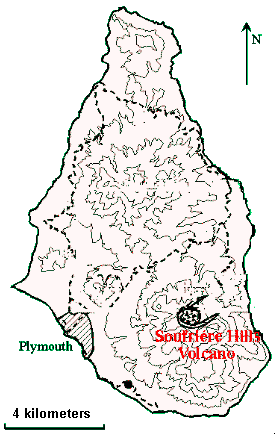
|
People may have worried but what could they do? Montserrat was their home. After each earthquake the people thought, "See, we are still in one piece. The volcano didn't blow!"
In mid July of 1995 the Montserrat volcano started to produce more earthquakes and a few days later, on July 18th the volcano's crater produced a phreatic explosion.
What's a phreatic explosion?
Phreatic (pronounced "free-a--tick") is from the Greek word for "well". Not "well" as in, "The eruption's going well.". It means "well" in the sense of water from the ground.

| When magma meets ground water a huge amount of steam is produced VERY quickly; so quickly that there is an explosion. This explosion is not quite like an explosion caused by dynamite. There is nothing inherently explosive in the chemicals of water and magma. The energy of a phreatic explosion is caused by the huge increase in pressure that occurs in the ground as the molten rock heats the ground water, turning the water to steam. It is similar to the explosion you would get if a pressure cooker were to suddenly rupture. |
Some of the earlier earthquakes may have been caused by "hidden" phreatic explosions that the ground was able to shake off and contain. Some folks saw these explosions as the volcano just blowing off some steam. Perhaps it would calm down now. Wrong! Instead there were more phreatic explosions as the volcano started blowing off its steam frequently. These phreatic emissions became an everyday event.
A few months later a dome started to grow.
| A magma dome is formed as magma pushes upward causing the land to bulge. This deformation is not a good sign. It means that the up-welling magma is making its way to the surface. It's like a balloon getting ready to pop. Well, no, that's not completely true. Magma domes don't "pop", they collapse. As a magma dome builds and grows it pushes the surface up and out. Eventually the surface gives way under its own weight. The dome collapses and releases the lava. |

|
On March 29th, 1996 a magma dome collapsed releasing its lava and producing the first of many pyroclastic flows.

| "Pyroclastic" means "fire rock" and that's a pretty good description of what comes pouring out of these kinds of volcanoes. However, it's the "flow" part of the pyroclastic that is the truly dangerous part. Pyroclastic flows are full of lava, hot rocks and gas so they flow like water but a lot faster! It's the pyroclastic flow that most people think about as an "eruption" and it is the pyroclastic flow that produces death and destruction very quickly. |
Soufriére Hills has been producing pyroclastic flows, on and off, for almost two years now and no one knows when it will stop or if it will get worse. On June 25th, 1997 a very large pyroclastic flow came down from Soufriére Hills. In a matter of minutes it dumped 4 to 5 million cubic meters of lava and covered 4 square kilometers on the east side of the island! It also killed at least nine people and destroyed more than a hundred homes. Anyone too close to a pyroclastic flow dies. The heat can ignite buildings and clothing. There are often poisonous gases mixed in too!
| Of less obvious worry is the tephra (pronounced "tef-ra") produced by the Soufriére Hills volcano. Tephra is just the scientific name for volcanic "ash". For many years people called the "stuff" that fell from volcanic clouds "ash", but geologists don't like to use that word because (they will argue) true "ash" is the product of combustion. That is, you get true "ash" from the burning of trees (and homes) caused by the pyroclastic flow, but tephra (any geologist will tell you) is made of tiny fragments of lava emitted from the volcano. So to distinguish between the two "ashes", we call the "ash" from the volcano tephra and reserve the word "ash" for, well, ash. |
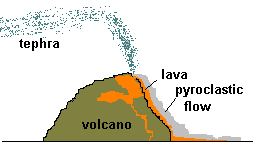
|
I once watched a TV show about volcanoes with a geologist
friend of mine. Every time the fellow on TV said "ash"
my friend would shout "TEPHRA!" (as if the guy on TV
would correct his error). And where did geologists come up with
this funny word? Tephra is Greek for "ash".
The tephra
cloud from Montserrat's big (June 25th) explosion rose 10 kilometers
and fell over the west side of the island covering the town of
Plymouth.
As tephra falls to earth it cools down. The further away tephra falls
from the volcano the more time it has to cool as it falls through
the air. So a tephra cloud can be very hot if it hasn't had time
to cool off.
In the year 79 (AD) a volcano in Italy called Vesuvius
erupted dumping a great deal of tephra on the nearby cities of
Pompeii and Herculaneum. It was still so hot that it covered the
people in a cloud of hot tephra and they died a quick, painful
death. Centuries later their bodies were discovered as hollow
"statues"; sculptured rocks coating human bodies that
had since decayed away. Some geologists called this stuff "hot
tephra" but others insist on describing it as a pyroclastic
flow of tephra. Take your pick.
Most tephra cools very
quickly as it falls so unless you are very close to the source
of the tephra it's only a nuisance. In 1980, when Mount St Helens
exploded, I watched scenes on the TV of the tephra falling all
over the place like black snow. It was the same with the evacuation
of the USA Air Force base in the Philippines when Mount Pinatubo
erupted in 1991. The tephra was everywhere. It was so thick it
turned the noonday black like nighttime!
Another danger from volcanoes are lahars. Lahar (pronounce "la-har") is an Indonesian word for mud flows. (I guess the Greeks don't have a word for it!) A lahar is a mixture of volcanic material and water and are a common problem in the volcanic areas where there are large volumes of ice and snow. The volcano's lava can melt a huge amount of glacial ice and thus release a huge amount of water. That water rushes away carrying any materials along with it. The result is a wall of flowing mud, sometimes very large and moving very fast. You might think lahars are impossible on the tropical island of Montserrat but you'd be wrong.
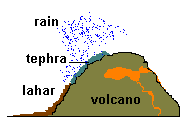
| OK, there are no snow fields or glaciers but Montserrat does have hot humid air. When a column of volcanic tephra rises into the upper atmosphere it commonly triggers storms. The tiny bits of tephra act as points for water condensation. It rains mud! Sometimes this mud-rain can fall in torrents and produce mud flows with enough force to sweep cars away and bury or drown people! Lahars can also be caused by normal rainstorms that fall on large amounts of tephra. The tephra left covering the Philippines from Pinatubo's 1991 eruption produces lahars with each rain storm. Many more people have been killed by Pinatubo lahars than the Pinatubo eruption itself. If enough tephra falls on Montserrat, lahars could become a problem with each rain. |
Despite all the excitement the Montserrat volcano is a typical volcano. Technically it is called a "strato volcano" because it is built of layers from older eruptions. Strato is a word geologists like to use for layers. Another name for this kind of volcano is a "composite volcano" referring to the fact that when it erupts it produces both lava and pyroclastic flows. Strato (composite) volcanoes are the most common type of volcano.
|
Another common feature of the Montserrat volcano is that
its magma is created by the subduction of local tectonic plates.
Huh? What I mean is that two plates of the earth's crust meet, push against each other and one of them gets pushed under. The material in the plate that gets pushed under is squeezed and heated until it melts. This magma then rises to the surface creating a volcano. Montserrat, like most volcanoes, is fed by the subduction of a nearby tectonic plate. |
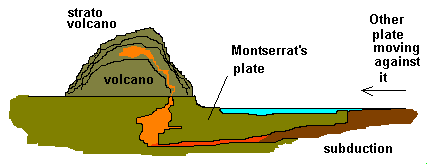
|
Perhaps the most typical thing about the Montserrat volcano is its behavior. No one can predict when a volcano like Montserrat will explode, but geologists monitoring these kinds of volcanoes can at least tell you when things are getting "tense". Like most volcanoes the Montserrat volcano started warning of its fate. The phreatic activity and earthquakes are a sign that magma is on the move and the formation of a magma dome is a sure sign that magma is approaching the surface.
Geologists monitoring Montserrat, Mount St Helens, Mount Pinatubo and similar volcanoes, keep a careful watch on the potential hazards. When earthquakes become more common and show signs of magma movement, the geologists take notice. When the amount of phreatic activity increases, they worry. And they constantly monitor magma domes. The more the domes deform, and the faster they do so, the more likely it is that the dome will collapse, releasing lava streams and pyroclastic flows. The geologists who monitor volcanoes (vulcanologists) can't predict the exact time of an explosion or even say how likely it is to explode. It's all kind of relative. However, they can monitor the volcano's behavior (earthquakes, phreatic activity and magma dome distortions) in order to make an educated guess. Sometimes they warn that it might explode and they issue an alert, calling for people near the troubled area to leave immediately. Sometimes they are wrong, but when they are right these warnings have saved the lives of many people living around active volcanoes (Montserrat, Mount Pinatubo and Mount St Helens).


If you have a comment or question about volcanoes feel free to send a
Letter to the Editor.
I can't promise to answer all your questions or address all your comments, but I'll post a few particularly good ones here.



The plates are riding around atop convection cells, but they may be dragged down into the cells in areas of subduction. However, most of the subducted material doesn't go very deep (by geological standards) and soon pops back up to the surface as a volcano because the Earth's surface is made of more buoyant materials than the convection cells.
Others may be asking, "What's a convection cell?"
The Earth gets rid of its deep heat by convection. Convection is the transfer of heat by the motion of molecules. As you heat a pot of water the hot water moves upward. Upon reaching the surface the water cools by giving off a lot of its heat to the air. Then the water sinks back to the bottom of the pot. This goes on continuously (as you heat the pot) and a series of "convection cells" form - hot water forms the upward part of the cell and cool(er) water forms the downward part of the cell. Convection cells made of molten rock are constantly churning away far below us bringing the heat from the Earth's interior close to the surface. When the heat is released the material sinks back down completing the cycle and the cell. The heat is released at the surface by another means of heat transfer called "conduction".
|
Conduction is the transfer of heat from one molecule to the other without the molecules themselves being moved along (otherwise it would be convection). As the convection cells approach the surface of the Earth the "thermal gradient" (hot Earth below and cool skies or water above) is sufficient to allow the heat to escape by the less energetic means of conduction. When you place your warm hand on a cold piece of metal you transmit heat from your hand to the metal by conduction. Molecules don't move from your hand to the metal. Instead the molecules move the heat by passing it along like a bucket brigade. About a hundred meters below the surface of the Earth the rocks heat up about one degree centigrade for every few hundred meters of depth. This is due to the conduction of heat from the tops of convection cells much further below. (The upper hundred meters or so don't have an obvious thermal gradient but it is there). Once the heat reaches the surface it is picked up by the air or water and carried away as atmospheric and oceanic convection and conduction. However, this heat is too small to cause the formation of atmospheric or oceanic convection cells because the local weather and ocean conditions dominate the heat transfer from the Earth's surface. Ultimately this "air-borne" heat is lost into space by "radiation". This should NOT be confused with the "radiation" of radioactive materials. |
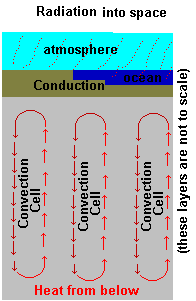
|
Radiation (in regards to heat transfer) is the loss of heat by giving off light - no molecules are moved and no molecules accept the heat from neighboring molecules. Radiation is the only way a body in space (a planet, a spaceship, etc.) can lose heat. This "light heat" is given off in a part of the spectrum we can not see called the "infra-red".
Now you know the three means of heat transfer, convection (hot molecules in motion), conduction (molecules passing the heat to their neighbors) and radiation (molecules giving off invisible light energy).
David went on to ask about the source of all this heat. Well, it comes from several sources. Some heat is generated from all that pressure (caused by gravity) squeezing the rocks. Then there is the "residual heat" left over from when the Earth was formed 4 or 5 billion years ago. This residual heat was made from the impact of colliding materials that made the Earth. And finally there is the heat from radioactive decay. That may surprise you. We don't often think about the heat generated by naturally occuring rocks. However a chunk of granite contains radioactive elements, mostly thorium (Th) and uranium (U), which produce heat as they decay. If none of the heat were allowed to escape the rock would melt (!) in about a million years. So it's easy to imagine that radioactivity contributes to the Earth's internal heat.
Geologists agree that the "residual heat" and heat generated by radioactive decay are the big producers.
We "surface creatures" get 98% of our heat from the sun. The remaining 2% is from the Earth's interior.





If you have a comment or question about lunar water feel free to send a Letter to the Editor. ![]()
I can't promise to answer all your questions or address all your comments, but I'll post a few particularly good ones here.


Return to the Science Explained Homepage.